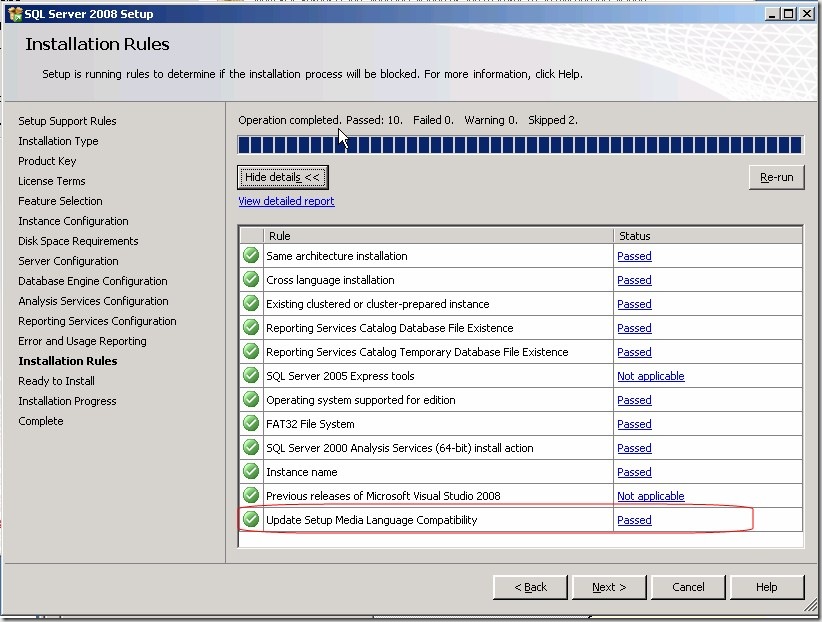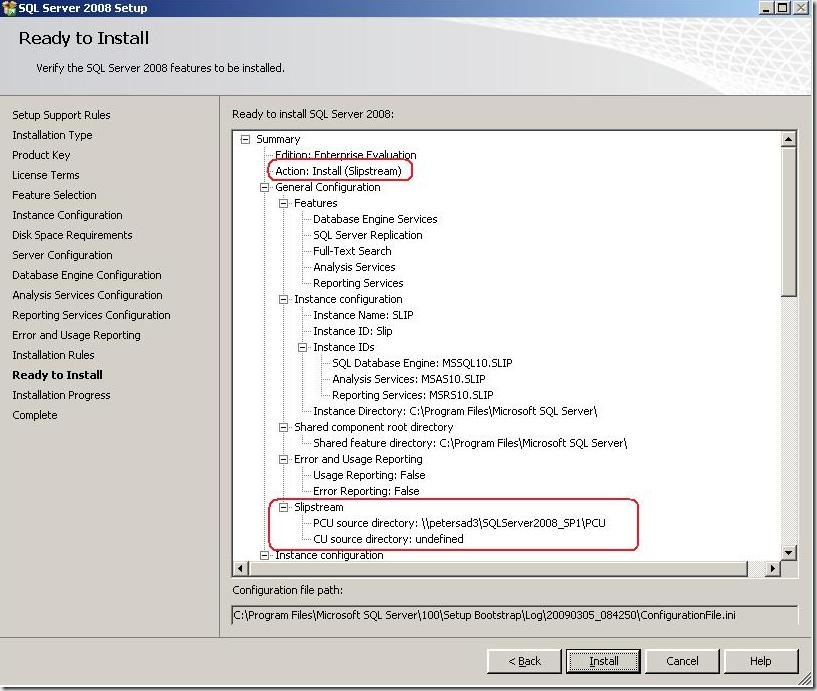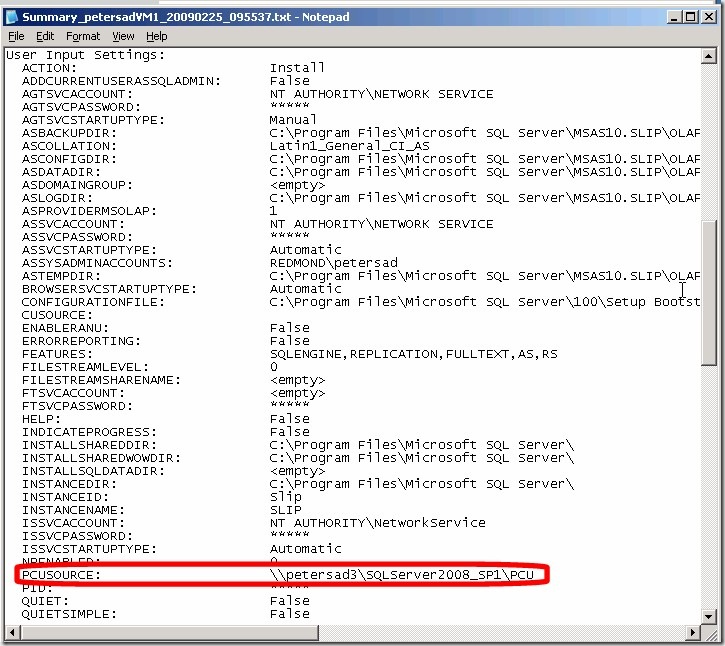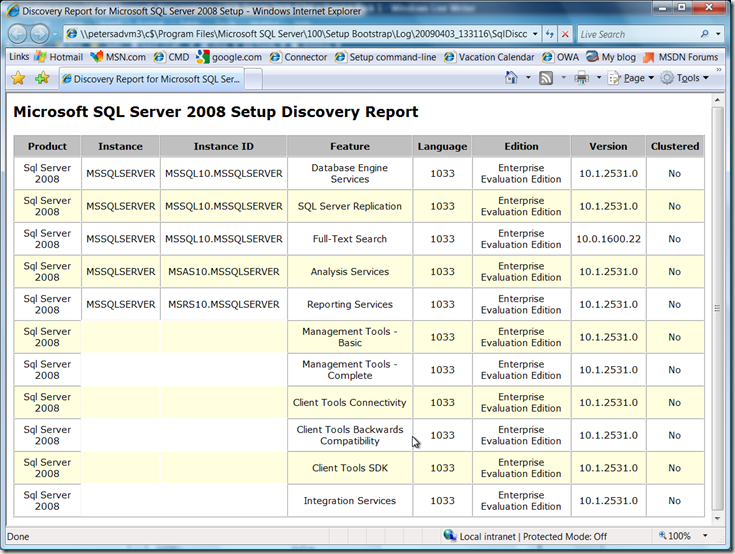Creating a merged (slipstreamed) drop containing SQL Server 2008 RTM + Service Pack 1
[Updated on April 7th, along with the availability of SQL Server 2008 SP1]
Today, I am going to show you how to create new source media that will slipstream the original source media and SQL Server 2008 Service Pack 1. Once you have created this drop, you can install SQL Server 2008 SP1 in a single step! These instructions are included with the Service Pack 1 release but there are some issues with the documentation that will be addressed in the next revision of the on-line documentation. There is not a lot of user interface that indicates you are slipstreaming, but there are a few clues, see at the bottom for screen shots.
These steps will take a little longer to perform than the steps for the basic slipstream describe here, but once completed you will be able to run a slipstream installation from the same location. It is recommended you verify you can complete a slipstream installation from the new drop on a test machine before deploying into production.
These instructions are for English SQL Server but will work with any language of SQL Server if you obtain the correct service package language.
1. Copy your original SQL Server 2008 source media to c:\SQLServer2008_FullSP1
2. Download Service Pack 1 from https://www.microsoft.com/downloads/details.aspx?FamilyID=66ab3dbb-bf3e-4f46-9559-ccc6a4f9dc19. The three architectures of Service Pack 1 should be included, the package names are as follows:
-
- SQLServer2008SP1-KB968369-IA64-ENU.exe
- SQLServer2008SP1-KB968369-x64-ENU.exe
- SQLServer2008SP1-KB968369-x86-ENU.exe
3. Extract the packages as follows:
- SQLServer2008SP1-KB968369-IA64-ENU.exe /x:c:\SQLServer2008_FullSP1\PCU
- SQLServer2008SP1-KB968369-x64-ENU.exe /x:c:\SQLServer2008_FullSP1\PCU
- SQLServer2008SP1-KB968369-x86-ENU.exe /x:c:\SQLServer2008_FullSP1\PCU
Ensure you complete this step for all architectures to ensure the original media is updated correctly.
4. Copy Setup.exe and Setup.rll from the PCU extracted location to original source media location
- robocopy C:\SQLServer2008_FullSP1\PCU c:\SQLServer2008_FullSP1 Setup.exe
- robocopy C:\SQLServer2008_FullSP1\PCU c:\SQLServer2008_FullSP1 Setup.rll
5. Copy all files not the folders, except the Microsoft.SQL.Chainer.PackageData.dll, in c:\SQLServer2008_FullSP1\PCU\<architecture> to C:\SQLServer2008_FullSP1 \<architecture> to update the original files.
- robocopy C:\SQLServer2008_FullSP1\pcu\x86 C:\SQLServer2008_FullSP1\x86 /XF Microsoft.SQL.Chainer.PackageData.dll
- robocopy C:\SQLServer2008_FullSP1\pcu\x64 C:\SQLServer2008_FullSP1\x64 /XF Microsoft.SQL.Chainer.PackageData.dll
- robocopy C:\SQLServer2008_FullSP1\pcu\ia64 C:\SQLServer2008_FullSP1\ia64 /XF Microsoft.SQL.Chainer.PackageData.dll
NOTE: if you accidentally copy the Microsoft.SQL.Chainer.PackageData.dll file, you may see this error when you launch Setup.exe. If this happens, restore Microsoft.SQL.Chainer.PackageData.dll back to the original version.
6. Determine if you have a defaultsetup.ini at the following locations:
- C:\SQLServer2008_FullSP1\x86
- C:\SQLServer2008_FullSP1\x64
- C:\SQLServer2008_FullSP1\ia64
If you have a defaultsetup.ini, add PCUSOURCE="{Full path}\PCU".
NOTE: The {Full path} needs to be the absolute path to the PCU folder. If you will just be running from local folder it would be C:\SQLServer2008_FullSP1. If you will eventually share this folder out, {Full path} would be \\MyServer\SQLServer2008_FullSP1.
See question #11 here if you would like to use a relative path.
;SQLSERVER2008 Configuration File
[SQLSERVER2008]
...
PCUSOURCE="{Full path}\PCU"
If you do NOT have a defaultsetup.ini, create one with the following content:
;SQLSERVER2008 Configuration File
[SQLSERVER2008]
PCUSOURCE="{full path}\PCU"
and copy to the following locations
-
- C:\SQLServer2008_FullSP1\x86
- C:\SQLServer2008_FullSP1\x64
- C:\SQLServer2008_FullSP1\ia64
This file will tell the setup program where to locate the SP1 source media that you extracted in step 3.
7. Now run setup.exe as you normally would.
How can I tell I am slipstreaming?
1) You should see the "Update Setup Media Language Rule" on the Installation Rules dialog:
2) You should see the Action indicate it is being slipstreamed and the Slipstream node should be shown:
3) You should see the PCUSource being specified in the Summary log:
4) After installing, if you run the "SQL Server features discovery report" off of the Installation Center you will see the following versions:
Comments
Anonymous
February 25, 2009
The SQL Server 2008 Express Service Pack 1 – CTP has been released.  The internal workings and layoutAnonymous
February 26, 2009
Thanks for giving it a try. For the CTP release, it is important to extract in the correct order as you pointed out. We'll be make setup.exe x86 for the final release so the order won't matter. You should be able to run with /QS and the configuration file, so let me know if you have further questions.Anonymous
February 26, 2009
I got the unattended install working for capturing the configuration.ini file from the manual install. The only difference is that ; The directory for the extracted service pack files used to update the setup media. PCUSOURCE="\FilesnetworkdownloadsDatabaseSQLServer2008DeveloperEditionWithSP1PCU" replaced MEDIASOURCE="\filesnetworkdownloadsDatabaseSQLServer2008DeveloperEdition"Anonymous
February 26, 2009
The purpose of this blog is to help you determine how to update an existing installation of SQL ServerAnonymous
March 02, 2009
Starting in SQL Server 2008 Service Pack 1, you can update the product using our "Slipstream"Anonymous
March 17, 2009
Last year you might have read my post where I showed you how to patch setup for RTM for SQL Server 2008Anonymous
April 07, 2009
You can find SP1 here . This service pack makes available Slipstream and SP uninstall .   Anonymous
April 07, 2009
SQLServer2008,basicslipstreamsteps[UpdatedonApril7th,alongwiththeavailabilityofSQLSe...Anonymous
April 08, 2009
Service Pack 1 for SQL Sevrer 2008 is now available (download link below). Two of the key features inAnonymous
April 08, 2009
I just followed the steps outlined in this article, plus the "Slipstream a SQL Server Update" in the SP1 setup helpfile, and successfully installed SQL 2008 + SP1. Thanks! In the help file, it has a step to copy sqlsupport.msi file from each architecture. But this blog post doesn't have it. Do we still need it? I followed help file and copied the msi files.Anonymous
April 08, 2009
You don't need to copy the sqlsupport.MSI over.Anonymous
April 09, 2009
Yesterday, along with several hundred other folks, I told you that SQL Server 2008 Service Pack 1 wasAnonymous
April 09, 2009
One of our readers sent me the following questions I think you will find valuable when understandingAnonymous
April 10, 2009
I saw some confusion around the availability of SP1 and CU4 on the web, therefore decided to put on aAnonymous
April 11, 2009
Now that SQL Server 2008 SP1 is released (download link here ), it is time to test a very interestingAnonymous
April 12, 2009
Das 1. Service Pack für den Microsoft SQL Server 2008 ist erschienen und kann heruntergeladen werden. Mit diesem SP1 kann man sich auch eine neue Installations-CD/DVD bauen, die es einem ermöglicht, bei einer Neuinstallation alles in einem Rutsch zu instAnonymous
April 13, 2009
It seems with steps 3, 4 and 5 that you practically end up with a duplicate set of SP1 files at the end of slipstream preparation -- one in SQLServer2008_FullSP1 and one in PCU. Did I read that correctly?Anonymous
April 15, 2009
Today, I am going to show you how to create new source media that will slipstream the original sourceAnonymous
April 16, 2009
The "SQL Server features discovery report" says verion 10.1.2531.0, but the serverproperty('ProductVersion') returns 10.0.2531.0! The 'ProductLevel' server property returns SP1Anonymous
April 17, 2009
El primer service pack para SQL 2008 ya está disponible, puedes bajarlo desde la siguiente direcciónAnonymous
April 17, 2009
El primer service pack para SQL 2008 ya está disponible, puedes bajarlo desde la siguiente direcciónAnonymous
April 25, 2009
General slipstreaming questions: Question #1: What is Slipstreaming? Answer: It is a term used to describeAnonymous
April 30, 2009
The comment has been removedAnonymous
April 30, 2009
Yes you are correct regarding the relative path. I actually noticed this the other day myself. Anyways I have clarified the instructions that the full patch is needed as the relative path may not always work.Anonymous
May 02, 2009
I wish I could create a slipstreamed DVD to install from. However, unless the DVD is in drive D: on every computer, then the PCUSOURCE="{Full path}PCU" requirement is troublesome.Anonymous
May 02, 2009
For this step:
- Copy all files not the folders, except the Microsoft.SQL.Chainer.PackageData.dll, in c:SQLServer2008_FullSP1PCU<architecture> to C:SQLServer2008_FullSP1 <architecture> to update the original files. is it possible to move the files instead so that they are not taking up double space on our file server?
- Anonymous
May 02, 2009
Regarding the last 2 comments:
- PCUSource comment: initially I documented PCUSource=.PCU but if you current folder is not the same as the location to setup.exe, the PCUSource folder could not be located since the command parameter does not support a relative path. However, if you plan to burn a DVD, .PCU might just work for you but I have not tried it. We need to fix the PCUSource, so it can support a relative path but the timeline is unknown. 2)"Moves the files" instead: No you can move all of the files in PCUSource location.
Anonymous
May 07, 2009
So, just for clarification... Step 7 says to run setup as you normally would...now, are you saying that no matter what I chose for my setup options, once it starts the setup, it will actually slipstream the bytes from those PCU folders into the rest of the media? Do the choices of installation options determine how much of the media gets slipstreamed? Or does all of this really only amount to the setup routine running the RTM setup and then running of SP1 right after?Anonymous
May 07, 2009
Slipstream merges the original files with the update to perform a "single" install. Only the files that need to be merged will be merged.Anonymous
May 08, 2009
Is it possible to slipstream CU1 into this as well?Anonymous
May 08, 2009
See http://blogs.msdn.com/petersad/archive/2009/04/16/create-a-merged-slipstream-drop-containing-sql-server-2008-server-pack-1-and-a-cumulative-update-cu-based-on-server-pack-1.aspx. You can not slipstream RTM + CU.Anonymous
May 11, 2009
The comment has been removedAnonymous
May 11, 2009
See question #11 at http://blogs.msdn.com/petersad/archive/2009/04/24/sql-server-2008-slipstream-frequently-asked-questions.aspx if you would like to use a relative path.Anonymous
May 14, 2009
When installing SQL Server 2005 RTM/SP1/SP2 and SQL Server 2008 RTM on Windows 7 RC it presents you withAnonymous
May 20, 2009
Visual Studio 2010 英語版プレリリースの提供が今週から開始されました。 ( VS2010 プレリリース 英語版 ページ ) 我々開発チームも開発の最終段階に入った Visual StudioAnonymous
May 22, 2009
is it possible slipstream Sql 2005 SP3 ..?Anonymous
May 23, 2009
No, it is not possible to Slipstream SQL 2005 SP3Anonymous
June 24, 2009
Is there a way to reduce the size of the setup? With slipstreamed setup we have to include both the original files and the SP1 files. Distributing an old file (because during the setup gets replaced by the service pack) is a waste of resources. I need a setup that installs directly SP1 (as the result of the slipstreamed setup) but takes less space. I need something like "Microsoft SQL Server 2008 Express with Advanced Services with Service Pack 1". Any hits on how to build it? (actually on microsoft site such download is not present)Anonymous
August 12, 2009
I tried this slipstream setup in Windows 7. It is successfully installed, but the problem is after installing the sql server, the msi installer is not closed it's transaction. It is difficult to install other softwares,the msiexec is not terminated. I can't uninstall or install any software due to this process. when i tried to install or uninstall any software, i am getting the error message that "another installation is in progress. complete that installation before proceeding with this install"Anonymous
August 12, 2009
The comment has been removedAnonymous
February 08, 2010
The comment has been removedAnonymous
March 24, 2010
The comment has been removedAnonymous
May 25, 2010
Thanks for this solution. It works for me. But I have to uninstall my initial installation since in it was completed, but with error. And the repair option didn't allow me to fix the problem. But after uninstalling and reinstalling using the slipstream, the installation completed successfully. Thanks again.Anonymous
July 21, 2010
Hello Peter, I got this message after trying to run the slipstream file. Setup did not recognize the PCUSOURCE in the defaultsetup.ini file. Thanks, Alan TITLE: SQL Server Setup failure.
SQL Server Setup has encountered the following error: The setting 'PCUSOURCE' specified is not recognized. Error code 0x84B40003.
Anonymous
July 21, 2010
Never mind about my previous comment about the PCUSOURCE error. It was not clear to me initially that I had to run all the robocopy commands in step 5. Thanks.Anonymous
December 28, 2010
Why not script the slipstream build process and provide an ISO of the slipstream with each SP and CU release? Or at least provide a script to automate the process. I have created a batch to build a slipstream from the RTM, SP, and CU files; however, it would be better if Microsoft provided the script and/or slipstream. I suspect that somebody at Microsoft creates a slipstream at some point for each SP and CU. It's not a productive use of our time to repeat the process.Anonymous
January 22, 2011
The comment has been removedAnonymous
March 08, 2011
Works!! Applied it to install SP2.Anonymous
July 13, 2011
I have create slip streamed according to step by step u've explain and the sql server 2008 was sucessfully installed but in management studio i still can't create database and login, i have no permittion to create any login and database. Can somebody help me..Anonymous
December 05, 2011
I just added a GUI tool to automate the Slipstreaming. sqlslipstreamer.codeplex.comAnonymous
January 31, 2012
WOW Finally microsoft guys heard me. ThanksAnonymous
March 26, 2014
Just so I am clear, when you say PCUSOURCE="{full path}PCU" would this be accurate "\serveroriginal_media_filesPCU" Or I did not need to include the word PCU? Or is PCU implied, meaning that the installation will look for a folder called PCU when it looks in \serveroriginal_media_files"? I ask because I followed the instructions, and the setup summary made no mention of the slipstream or the install type. I am trying to install SQL Server 2008 Developers edition, and slip stream with SP1 x86Anonymous
March 27, 2014
I got it figured out, now just need to know if or how to include the book online.Anonymous
April 02, 2014
Can someone explain how to add the latest version of BOL to the package? I know there is books online with the service pack, however, I have 2009 updated version I would like to add.




